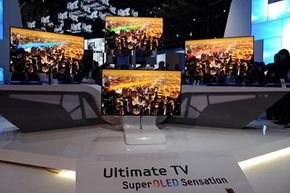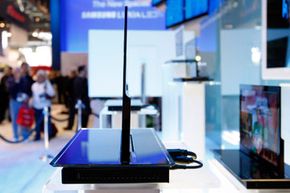If you're both a technology buff and a sci-fi fan, you probably remember that incredibly cool giant transparent screen that Tom Cruise's character gazed at in the 2002 movie "Minority Report" [source: Tomcruise.com]. Even if you aren't a hunky clairvoyant of the future, wouldn't it be great to have a television like that? Well, pretty soon, you may be able to.
For a couple of decades now, electronics manufacturers have been working to develop screens that use an innovation called organic light-emitting diodes. OLEDs -- if you believe the hype -- will dramatically transform our TV-viewing experience. Basically, OLEDs are big sheets of plastic between layers of glass that give off light when zapped with tiny bits of electricity. They're amazingly thin and energy-efficient, and their crisp, vivid images look great from almost any angle. Those qualities make them seemingly ideal for the sort of massive, wall-sized TV screens that we love for watching sports and admiring the intricate footwork on "Dancing with the Stars." And an OLED screen is much lighter and more flexible than a conventional flat-panel, so it would be easy to move even a huge one from room to room, or embed it in a wall. But for would-be Tom Cruises, the really slick feature of OLEDs is that they're pretty much transparent, except for the images they display [sources: Kanellos, Blau]. One manufacturer, Haier, already has released a promotional photo showing a man's hand reaching behind a TV screen. It's so crystal clear that a fortune teller practically could read his lifeline through it [source: Baldwin].
Advertisement
But while manufacturers have been displaying prototypes of transparent TV screens at industry shows for years, they've been much slower at actually getting such gadgets into stores. As this article is being written, the latest promise is that they'll go on sale widely in 2013 [source: Savov].


